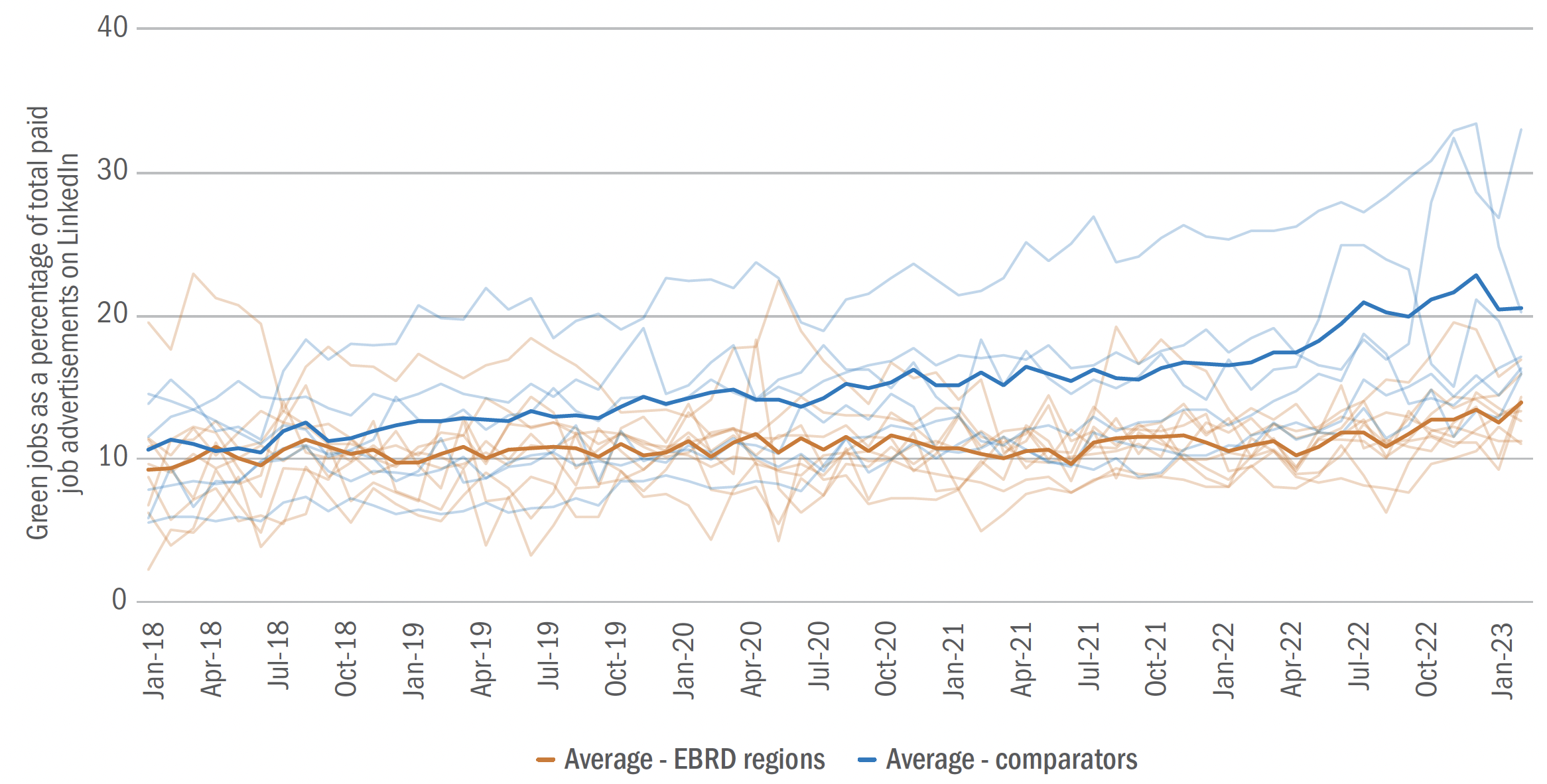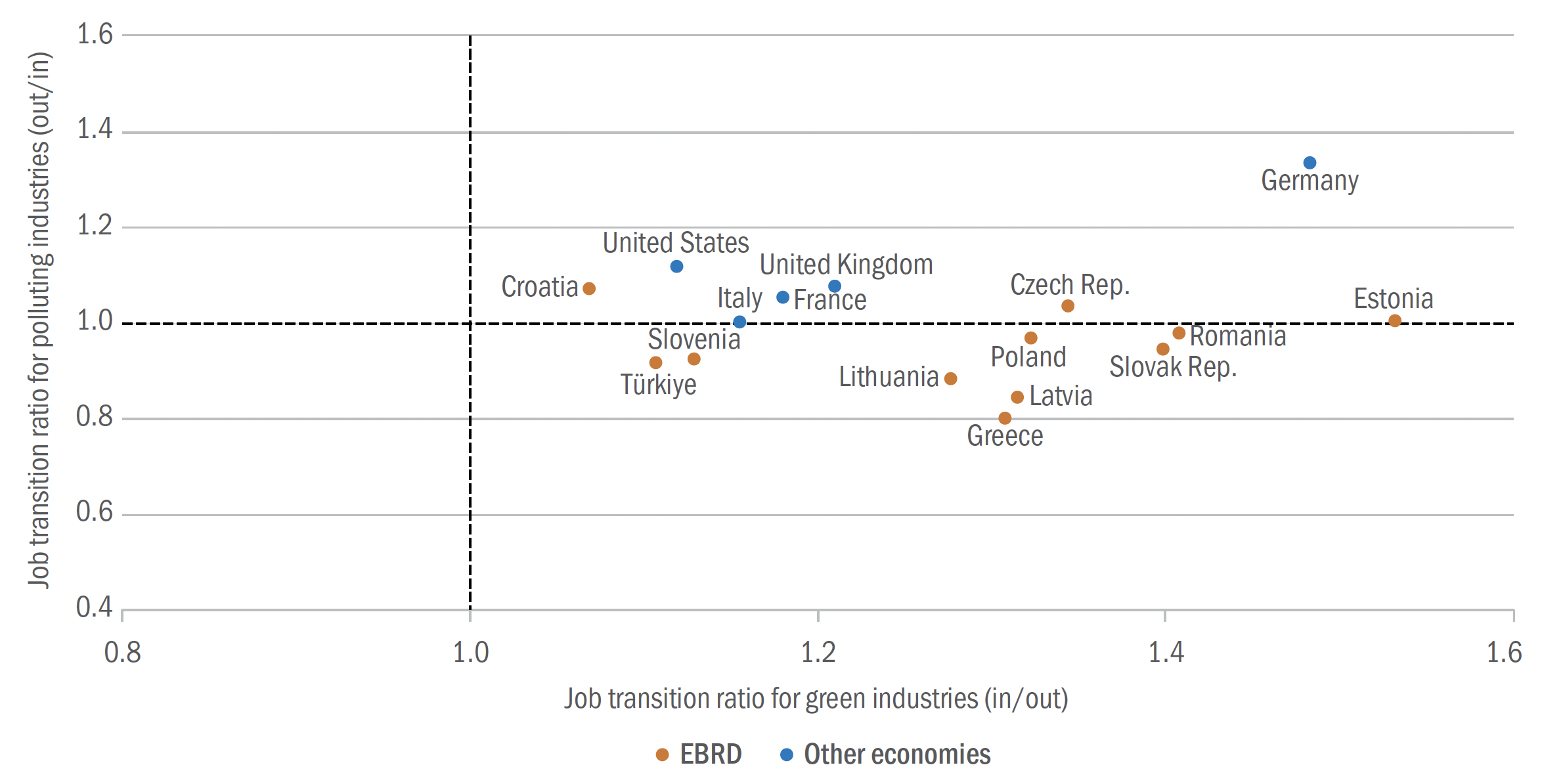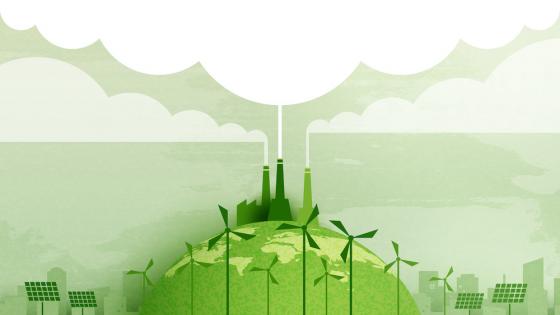Public support for environmental policies depends not only on their ecological benefits, but also on their perceived economic implications. Most people’s perceptions are shaped by their own experience and they feel the implications of the green transition most directly in the labour market. On the one hand, the green transition can create ‘good jobs’ that are less prone to geographical concentration, dehumanising repetitive tasks, and automation or delocalisation (Terzi 2022). On the other hand, evidence shows that past green fiscal stimulus packages were effective in creating jobs only in the long run, but not in the short run (Popp et al. 2020). This column presents findings from the EBRD’s Transition Report 2023-24 (EBRD 2023), which documents what the transition to a green economy means for labour markets.
Attitudes towards the green economy
We use data from the most recent wave of the Life in Transition Survey (LiTS IV), conducted in 2022 and 2023 by the EBRD and the World Bank, to explore people’s attitudes towards climate policies and support for green action. Overall, people living in emerging Europe (as well as Germany) recognise that climate change is real and has serious consequences. However, those beliefs do not necessarily translate into a willingness to pay higher taxes or forgo economic growth and job creation to prioritise environmental policies. For instance, only 43% of surveyed individuals would prioritise the environment at the expense of economic growth and jobs. Unwillingness to support green policies tends to be greater among the socio-economic groups that are most vulnerable to such changes, including those in the bottom half of the income distribution and the less educated.
Demand for skills and labour mobility
The green transition cannot take place without an adequately skilled workforce that can satisfy the demands of a greener economy. Demand for workers with green skills is already on the rise, and our analysis documents a wage premium of 4% for such workers. However, that green premium accrues disproportionately to highly skilled workers and less to individuals who are more likely to be climate sceptics.
The green wage premium suggests that demand for green skills in the market exceeds the supply of workers with the requisite skills. Our analysis draws on the online activity of more than 200 million LinkedIn members across several economies in the EBRD regions where LinkedIn Economic Graph data are sufficiently representative of job vacancies, job to job transitions and job seekers’ skills. We also use France, Germany, Italy, the UK and the US as comparators.
Across the EBRD regions, green jobs accounted for 14% of total paid job postings at the beginning of 2023, up from just under 9% in 2018 (see Figure 1). In the advanced comparator economies, this ratio – a measure of demand for green skills – increased more rapidly, from 10% to 21% on average over the same period.
Figure 1 Green jobs are increasing as a percentage of total paid job postings
Source: LinkedIn (via the Development Data Partnership) and authors’ calculations.
Note: The pale lines indicate the ratios for individual economies. The figures for the EBRD regions cover Croatia, the Czech Republic, Estonia, Greece, Latvia, Lithuania, Poland, Romania, the Slovak Republic and Türkiye. The comparator countries are France, Germany, Italy, the UK and the US.
Despite a substantial wage premium in green sectors, mobility from brown to green sectors remains limited in the EBRD regions. LinkedIn data indicate that there was a net flow of workers into green activities between 2015 and 2023 across all economies (i.e. more workers moved into green industries than moved out of them; see Figure 2). Average net rates of transition into green activities were similar across the EBRD regions and advanced comparators. However, there was also a net flow into polluting industries in the EBRD regions over that period: more workers found new employment in brown industries than left those industries. In advanced comparators, by contrast, there was a net outflow of workers from brown industries.
Figure 2 Between 2015 and 2023, more workers moved into green industries than moved out of them
Source: LinkedIn (via the Development Data Partnership) and authors’ calculations.
Note: The vertical axis measures the number of workers moving out of a brown sector divided by the number moving into such a sector (so figures in excess of 1.0 denote a net outflow). The horizontal axis indicates the number of workers moving into a green sector divided by the number moving out of such a sector (so figures in excess of 1.0 denote a net inflow).
Green innovation and labour markets
The arrival of new green technologies may create or destroy jobs. Over the last few decades, technological change in advanced economies has typically been found to be labour-substituting, with a specific bias against routine tasks (Autor 2015). Yet, innovation also has the potential to be labour-augmenting, complementing the tasks performed by workers and increasing demand for labour.
We analyse how the development of green technologies affects local labour markets by drawing on individual-level data from the EU Labour Force Surveys (EU-LFS). We combine these data with information on patents filed at the USPTO and new green technologies as classified by the EPO. We then develop a novel measure of exposure to green technologies vis-à-vis non-green technologies for each occupation at the three-digit level of the ISCO classification (Kogan et al. 2021, Autor et al. 2022).
Our analysis links local employment growth in each occupation to a measure of exposure to green innovation and various local labour market characteristics. It shows that an occupation’s overall exposure to technological innovation tends, on average, to be labour-substituting. However, this labour-substituting effect is more muted where exposure to green innovation is greater. Since some occupations are more exposed to green innovation than others, workers with certain characteristics who dominate these occupations will be affected more by green technologies. For instance, we find that workers with less education are more likely to have occupations with greater exposure to green innovation (see Figure 3).
Figure 3 Less-educated workers are more exposed to green innovation
Source: USPTO, EPO, EU Labour Force Survey and authors’ calculations.
Note: Shares are first calculated by occupation and averaged using education-specific weights based on occupation patterns. The sample comprises Bulgaria, the Czech Republic, Estonia, Greece, Hungary, Latvia, Lithuania, Poland, the Slovak Republic and Slovenia in the EBRD regions, plus Germany, Italy, Spain and the UK as comparators.
Fast and slow green transitions
How quickly the demand for new skills is met in the labour market will, to a large extent, determine the speed at which countries can roll out green technologies. Experience gained from the ICT transition suggests that skills mismatches have the potential to persist as local markets slowly adjust (Adão et al. 2022). In particular, workers find it harder to transition into jobs with strong skill specificity.
We analyse the speed at which local labour markets have adjusted to green transitions over the past two decades using individual level data from the EU-LFS. The results indicate that labour markets adjust fairly slowly in the face of a green transition. The employment shares of occupations which had greater exposure to green innovation in 2000 did not experience significant changes during the first decade of this century, but showed stronger growth only from 2015 onwards.
Policy implications
The energy transition offers many new employment opportunities but risks leaving behind lower-skilled, informal workers that have pollution-intensive jobs (World Bank 2023). Labour market adjustment costs can be minimised by using the existing skill sets of workers who are at the greatest risk of displacement in a local area, helping them to move into nearby jobs that require limited reskilling. This should be done with the explicit cooperation and guidance of local businesses. However, there will inevitably be adaptation challenges for specific workers and industries, who will need help in the form of reskilling and training programmes. A strong labour market that is bolstered with social safety nets can enable displaced workers to move across sectors and find new jobs. Because the green transition affects different geographical areas in different ways, a location-based strategy for business support and development will need to complement national policies.
References
Adão, R, M Beraja and N Pandalai-Nayar (2022), “Fast and slow technological transitions”, mimeo.
Autor, D H (2015), “Why are there still so many jobs? The history and future of workplace automation”, Journal of Economic Perspectives 29(3): 3-30.
Autor, D H, C Chin, A M Salomons and B Seegmiller (2022), “New Frontiers: The Origins and Content of New Work, 1940-2018”, NBER Working Paper No. 30389.
EBRD (2023), EBRD Transition Report 2023-24: Transitions Big and Small, Chapter 3, London.
Kogan, L, D Papanikolaou, L D W Schmidt and B Seegmiller (2021), “Technology, vintage-specific human capital, and labor displacement: Evidence from linking patents with occupations”, NBER Working Paper No. 29552.
Popp, D, F Vona, and J Noailly (2020), “Green stimulus, jobs and the post-pandemic green recovery”, VoxEU.org, 4 July.
Terzi, A (2022), “A green industrial revolution is coming”, VoxEU.org, 28 June.
World Bank (2023), “South Asia Development Update, October 2023: Toward Faster, Cleaner Growth”.









